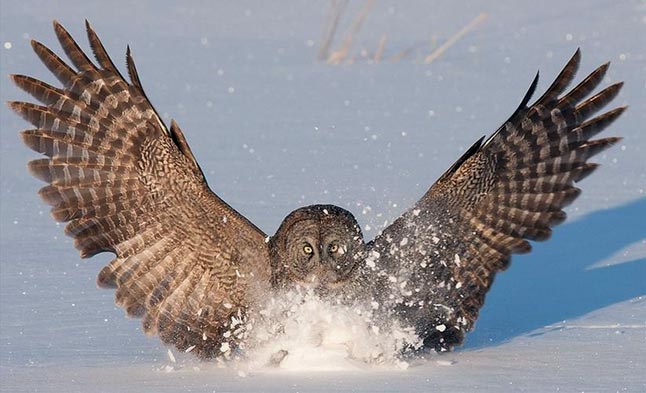Owl wing design reduces aircraft, wind turbine noise pollution

The shape of owl wings, which help the animals fly quietly, can inform airfoil designs.
Credit: Wang and Liu
Serrated edge of owl wings makes them quieter than other birds, can help inform airfoil designs.
Trailing-edge noise is the dominant source of sound from aeronautical and turbine engines like those in airplanes, drones, and wind turbines. Suppressing this noise pollution is a major environmental goal for some urban areas.
In Physics of Fluids, by AIP Publishing, researchers from Xi’an Jiaotong University used the characteristics of owl wings to inform airfoil design and significantly reduce the trailing-edge noise.
“Nocturnal owls produce about 18 decibels less noise than other birds at similar flight speeds due to their unique wing configuration,” said author Xiaomin Liu. “Moreover, when the owl catches prey, the shape of the wings is also constantly changing, so the study of the wing edge configuration during owl flight is of great significance.”
Trailing-edge noise is generated when airflow passes along the back of an airfoil. The flow forms a turbulent layer of air along the upper and lower surfaces of the airfoil, and when that layer of air flows back through the trailing edge, it scatters and radiates noise.
Previous studies explored serrated trailing edges, finding that the serrations effectively reduce the noise of rotating machinery. However, the noise reduction was not universal, depending heavily on the final application.
“At present, the blade design of rotating turbomachinery has gradually matured, but the noise reduction technology is still at a bottleneck,” said Liu. “The noise reduction capabilities of conventional sawtooth structures are limited, and some new nonsmooth trailing-edge structures need to be proposed and developed to further tap the potential of bionic noise reduction.”
The team used noise calculation and analysis software to conduct a series of detailed theoretical studies of simplified airfoils with characteristics reminiscent of owl wings. They applied their findings to suppress the noise of rotating machinery.
Improving the flow conditions around the trailing edge and optimizing the shape of the edge suppressed the noise. Interestingly, asymmetric serrations reduced the noise more than their symmetric counterparts.
Noise reduction varied with different operating conditions, so the scientists emphasized that the airfoil designs should be further evaluated based on the specific application.
For example, wind turbines have complex incoming flow environments, which require a more general noise reduction technology. Examining noise reduction techniques under the influence of different incoming flows would make their conclusions more universal.
The researchers believe their work will serve as an important guide for airfoil design and noise control.
The article “Aeroacoustic investigation of asymmetric oblique trailing-edge serrations enlightened by owl wings” is authored by Lei Wang and Xiaomin Liu. The article will appear in Physics of Fluids on Jan. 18, 2022 (DOI: 10.1063/5.0076272). After that date, it can be accessed at https://aip.scitation.org/doi/full/10.1063/5.0076272.
ABOUT THE JOURNAL
Physics of Fluids is devoted to the publication of original theoretical, computational, and experimental contributions to the dynamics of gases, liquids, and complex fluids. See https://aip.scitation.org/journal/phf.
Journal: Physics of Fluids
DOI: 10.1063/5.0076272
Article Title: Aeroacoustic investigation of asymmetric oblique trailing-edge serrations enlightened by owl wings
Article Publication Date: 18-Jan-2022
Media Contact
Larry Frum
American Institute of Physics
media@aip.org
Office: 301-209-3090
All latest news from the category: Physics and Astronomy
This area deals with the fundamental laws and building blocks of nature and how they interact, the properties and the behavior of matter, and research into space and time and their structures.
innovations-report provides in-depth reports and articles on subjects such as astrophysics, laser technologies, nuclear, quantum, particle and solid-state physics, nanotechnologies, planetary research and findings (Mars, Venus) and developments related to the Hubble Telescope.
Newest articles
Faster, more energy-efficient way to manufacture an industrially important chemical
Zirconium combined with silicon nitride enhances the conversion of propane — present in natural gas — needed to create in-demand plastic, polypropylene. Polypropylene is a common type of plastic found…

Energy planning in Ghana as a role model for the world
Improving the resilience of energy systems in the Global South. What criteria should we use to better plan for resilient energy systems? How do socio-economic, technical and climate change related…

Artificial blood vessels could improve heart bypass outcomes
Artificial blood vessels could improve heart bypass outcomes. 3D-printed blood vessels, which closely mimic the properties of human veins, could transform the treatment of cardiovascular diseases. Strong, flexible, gel-like tubes…





















